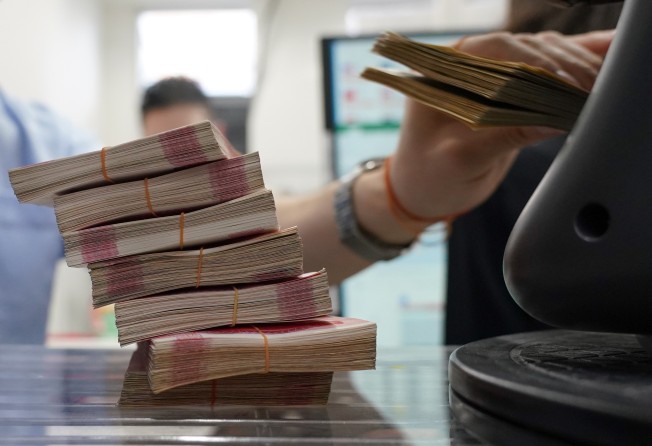China’s yuan strengthens past 7 per US dollar amid easing of coronavirus curbs
- China’s onshore yuan finished the domestic trading session on Monday at 6.9561 per US dollar, the strongest close since September 13
- The currency was bolstered by Beijing easing some coronavirus curbs and expectations of slower US interest rate increases

China’s yuan firmed past the closely watched level of 7-per-US dollar on Monday, closing at its strongest since mid-September, as Beijing eased some of its strict coronavirus curbs, potentially attracting fresh foreign inflows.
The Chinese currency was also bolstered by expectations of slower US interest rate increases, which knocked the US dollar index to near five-month lows.
China’s onshore yuan eventually finished the domestic trading session on Monday at 6.9561, which was its strongest level since September 13.
The People’s Bank of China had earlier set the yuan’s midpoint at 7.0384, which was the strongest level since November 16, with the currency allowed to trade within a 2 per cent range on either side.
The blue-chip CSI 300 Index in Shanghai also closed up 2 per cent, while Hong Kong’s Hang Seng Index climbed 4.5 per cent to end at the highest level since September 1.
Other Asian shares, meanwhile, extended their rally, as investors hoped a China reopening would eventually brighten the outlook for global growth and commodity demand.
“The China reopening trade maintained its strong momentum in the beginning of this week. The positive headlines continued to fuel risk sentiment in China,” said Ken Cheung, chief Asian foreign exchange market strategist at Mizuho Bank.
Maybank also attributed the yuan’s strength to “the broader depreciation in the [US dollar]”. The US dollar index has slumped by nearly 9 per cent from its September 28 peak.
But the bank also warned that China’s road for economic recovery could be bumpy and that the yuan will remain volatile.
Potential “policy U-turns or worsening of the infections could be seen as opportunities to short” the currency, Maybank said.
Last week, the yuan jumped by around 1.6 per cent, its biggest weekly gain since 2005 amid expectations authorities will continue to loosen strict virus curbs.
More cities, including financial hub Shanghai and Urumqi in the far west, announced an easing of curbs over the weekend as China tries to make its zero-Covid policy more targeted and less onerous after unprecedented protests against restrictions.
China’s benchmark CSI 300 index jumped by nearly 10 per cent in November, as mainland stocks witnessed monthly net inflows exceeding 60 billion yuan (US$8.54 billion) via the cross-border Stock Connect scheme.
Morgan Stanley on Sunday upgraded China’s equities to overweight, citing “multiple positive developments alongside a clear path set towards reopening”.
The Wall Street bank joined a slew of global institutions, including UBS and Goldman Sachs, in turning bullish toward China on expectations of an eventual reopening of the economy.
Standard Charted expects China’s real urban household consumption growth to accelerate to 7 per cent in 2023, from 0.2 per cent in 2022, forecasting China will remove most coronavirus restrictions by the second quarter of 2023.